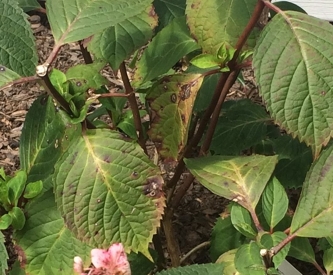The Greatest Guide To Hydrangea Leaves Turning Yellow
Wiki Article
Hydrangea Leaves Turning Yellow Things To Know Before You Get This
Table of ContentsThe Ultimate Guide To Hydrangea Leaves Turning YellowThe Hydrangea Leaves Turning Yellow IdeasAbout Hydrangea Leaves Turning YellowUnknown Facts About Hydrangea Leaves Turning YellowHydrangea Leaves Turning Yellow Fundamentals ExplainedThe Facts About Hydrangea Leaves Turning Yellow Uncovered
One opportunity is that the plant is not obtaining enough sunshine. During the winter season, the days are much shorter, and the sun is not as intense, so make certain to position your Hydrangea in a place where it will certainly obtain at least six hours of sunshine every day. One more reason for Hydrangea yellow leaves in winter might be also much water.Ultimately, the leaves may be turning yellow due to temperature level stress and anxiety. Hydrangeas like cooler temperatures, so if the plant is in an area that gets too hot or also cool, the leaves will certainly turn yellow. If you think temperature stress could be the problem, attempt relocating your Hydrangea to a various area or safeguarding it from the elements with a burlap wrap.
New growth will be observed in early spring, when you'll notice green foliage sprouting from stems that could have shown up dead. If your fallen leaves are turning brown in springtime or summer season, there are likely various other elements at play (Hydrangea Leaves Turning Yellow). The exact factors depend upon the variety and their expanding conditions, however generally, brownish hydrangea fallen leaves are an indicator of dehydration and wilting in the heat
Little Known Facts About Hydrangea Leaves Turning Yellow.

Wilting is triggered by lack of dampness, meaning there are a few good methods to use to avoid this from occurring. Offer your hydrangeas a healthy glug of water every couple of days when the temperatures are climbing up high, and treat the soil to much better maintain wetness. After watering, a dab of mulch around the base of each plant must assist with this by maintaining moisture in the dirt.
This disrupts fungis spores from settling. "The Botrytis fungus grows in great and wet conditions, so prevent showering the entire plant when watering and simply water at the origins," shares Roy Nicol, a Master Horticulturist. If you've missed the chance for prevention and are handling an infection you ought to remove all dead or severely infected leaves from the plant and ruin them to protect against more spread.
All about Hydrangea Leaves Turning Yellow
As a general policy of thumb, we suggest eliminating fallen leaves when they are 50% brownish or higher. While browning brought on by any kind of factor can not be reversed, taking the corrective activity explained above will urge the plant to expand brand-new fallen leaves so the harmed leaves either fall off normally or can be eliminated by the garden enthusiast.Hydrangeas should be watered just when the leading couple of inches of dirt are completely dry, and must be given a complete soaking each time. Underwatered hydrangeas are most likely to have yellow, get redirected here wilting, and sagging fallen leaves.
The means you repair hydrangea leaves turning yellow relies on the vital concern triggering the yellow fallen leaves. This can be hard to determine, however once you do you will certainly have the ability to change your plant treatment appropriately to deal with the issue. As stated previously, an usual issue with hydrangeas is nutrient deficiencies.
A Biased View of Hydrangea Leaves Turning Yellow
During the height expanding season, you need to water at a rate of regarding 1 inch weekly. If you are bothered with not effectively sprinkling your hydrangeas, there are a pair of things you can do. Adding mulch to the base of the plants over the root area assistance to manage the temperature level around the shrub and preserve water in the dirt.Alternatively, you can purchase and install basic watering worlds. Sprinkling globes hold water in them and slowly release this water right into the dirt as the ground comes to be completely dry. Simply fill up the globe with water, stick the spout right into the dirt within the root zone near the base of the plant, and leave it in position up until all the water is gone.
If it is as well severe, some plants will certainly never ever recover from transplant shock and will remain to decrease up until they die. Minimize transplant shock by including as many roots as feasible when excavating up your plant to relocate. Be certain to offer more water than typical in the weeks following growing to assist your plant recuperate and expand new roots.
Indicators on Hydrangea Leaves Turning Yellow You Should Know
To stay clear of spreading out fungal conditions, make sure to thouroughly tidy and decontaminate any type of trimming tools prior to and after usage. You can attempt to flush the roots with water to eliminate excess fertlizer.Your hydrangea plant chooses well-drained, damp soil. If the pot has inadequate drain, or your dirt is swamped, the leaves will certainly start to turn yellow. Overwatering makes the soil soggy (Hydrangea Leaves Turning Yellow). Flooded and soaked soil can cause stunted growth, leaf discoloration, and, worst of all, rot fungal illness. Despite the fact that over-watering can be damaging, under-watering is not an alternative either.
If you don't sprinkle your hydrangea visit our website plant for greater than a week, the leaves will begin turning yellow. Fungal illness that strike the plants have a tendency to show join the origins and the leaves of the plant. One of these conditions is root rot, which makes it hard for the plant to feed effectively.
Some Of Hydrangea Leaves Turning Yellow

Report this wiki page